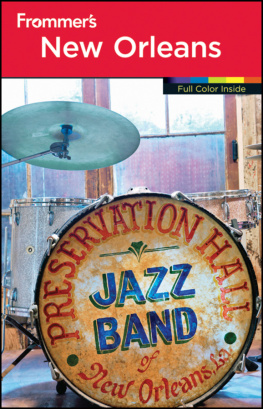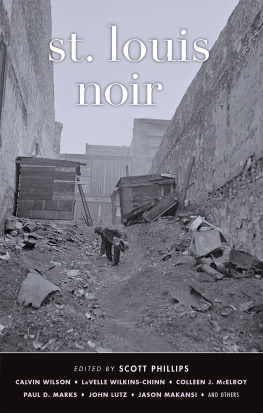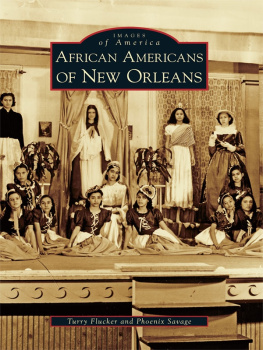NEW ORLEANS, LOUISIANA
& SAINT-LOUIS, SENEGAL
Mirror Cities in the Atlantic World, 16592000s
Edited by Emily Clark, Ibrahima Thioub,
and Ccile Vidal

LOUISIANA STATE UNIVERSITY PRESS
BATON ROUGE
Published by Louisiana State University Press
Copyright 2019 by Louisiana State University Press
Asserting Citizenship and Refusing Stigma: New Orleans Equal-Rights Activists
Interpret 1803 and 1848 is copyright 2019 by Rebecca J. Scott.
All rights reserved
Manufactured in the United States of America
First printing
DESIGNER: Michelle A. Neustrom
TYPEFACE: Adobe Garamond Pro
PRINTER AND BINDER: Sheridan Books, Inc.
LIBRARY OF CONGRESS CATALOGING-IN-PUBLICATION DATA
Names: Clark, Emily, 1954 editor. | Thioub, Ibrahima, editor. | Vidal, Ccile, editor.
Title: New Orleans, Louisiana, and Saint-Louis, Senegal : mirror cities in the Atlantic world, 16592000s / edited by Emily Clark, Ibrahima Thioub, and Ccile Vidal.
Description: Baton Rouge : Louisiana State University Press, [2019] | Includes bibliographical references and index.
Identifiers: LCCN 2019005200 | ISBN 978-0-8071-7111-0 (cloth : alk. paper) | ISBN 978-0-8071-7170-7 (pdf) | ISBN 978-0-8071-7171-4 (epub)
Subjects: LCSH: New Orleans (La.)History. | Saint Louis (Senegal)History. | BlacksLouisianaNew OrleansSocial conditions. | BlacksSenegalSaint LouisSocial conditions. | SlaveryLouisianaNew Orleans (La.)History. | SlaverySenegalSaint LouisHistory. | New Orleans (La.)Race relationsHistory. | BlacksFranceColonies. | Port citiesCase studies.
Classification: LCC F379.N557 N485 2019 | DDC 976.3/35dc23
LC record available at https://lccn.loc.gov/2019005200
The paper in this book meets the guidelines for permanence and durability of the Committee on Production Guidelines for Book Longevity of the Council on Library Resources.

INTRODUCTION
CCILE VIDAL, EMILY CLARK, AND IBRAHIMA THIOUB
O n March 19, 1731, a wedding ceremony took place in the New Orleans church that brought together the worlds of Senegambia and Louisiana. The Capuchin missionary Hyacinthe united Simon Vanon, a free negro born in Senegal, with Marie Anne, a Senegalese free negress. Simon Vanon and Marie Anne probably did arrive in New Orleans from Saint-Louis. However, it is impossible to decipher their precise ethnic backgrounds and to know whether they arrived free or obtained their freedom in the Mississippi Valley. Their union, nevertheless, testifies to the early entangled histories of Saint-Louis and New Orleans and invites a consideration of the two port cities over the course of the Atlantic age that spawned their earliest connection with one another. By mirroring their histories, this collective volume aims at recovering the crucial role played by port cities in the integration of the Atlantic world. It also argues that Africa must be given the same place as the Americas in Atlantic studies and that historians need to reconsider how the interplay of imperialism, colonialism, and slaving that defined the early Atlantic world operated and evolved differently on both sides of the ocean. Finally, it seeks to contribute to a better understanding of the particularities of the French Empire within the Atlantic world.
WHY SAINT-LOUIS AND NEW ORLEANS, SEPARATELY AND TOGETHER?
Saint-Louis and New Orleans were two river towns created ex nihilo by the French, the former in West Africa and the latter in North America, at the time of French early imperial expansion in the Atlantic world. Both became important port cities of their own continents, the Atlantic world as a whole, the African diaspora, and the Atlantic portion of the French Empire. Saint-Louis was founded first, in 1659, with the internationalization of the transatlantic slave trade. Whereas the Portuguese had dominated the commerce of slaves to the Americas for most of the sixteenth century, the Dutch, French, and English breached their monopoly over the course of the seventeenth century. Senegambia was a particularly attractive region because it was close to both Europe and the Americas. These three European powers created zones of influence to supply the colonies they had simultaneously begun to develop in the Caribbean. New Orleans was established much later, in 1718, after the transatlantic slave trade had greatly expanded and plantation slavery was already well entrenched in the French Antilles. The French had started to settle in Louisiana in 1699 to impede the English from getting closer to the Spanish and to block their westward expansion. The first phase of settlement had taken place on the Gulf of Mexico, but the colonizing effort was redirected toward the Mississippi Valley after the monopoly on the Louisiana trade was granted to the Company of the Westlater named Company of the Indiesin 1717. The Companys initial project, besides exploiting the mythic gold mines of the Illinois Country and expanding trade with neighboring Spanish colonies, was to develop a plantation society and economy, growing tobacco and indigo with a mixed labor force of African slaves and European indentured servants and convicts.
The sites of Saint-Louis and New Orleans were chosen because they controlled the mouth of a river that gave access to the interiors of West Africa and North America, respectively. The ocean is much nearer in Saint-Louis than in New Orleans. The former was founded fifteen miles from the mouth of the Senegal River, on an inhabited island in the middle of the river that could be easily defended, separated from the ocean by a sandbar named the Langue de Barbarie. Located at a distance of about one hundred miles from the Gulf of Mexico, New Orleans was established on the top of a meander of the Mississippi River, in the vicinity of a Native American portage that gave two points of access to the sea, through the Mississippi River and through Lake Pontchartrain. The location of each city, nevertheless, allowed it to maintain connections with and even to control over time a large continental hinterland: for Saint-Louis, much of the Western Sahara, the upper and middle Niger Valleys, and the north of Senegambia; and for New Orleans, the whole Mississippi Basin. Yet, during the early modern period, the territories acquired and occupied by European or US imperial powers were discontinuous and limited mostly to coastal enclaves in Senegambia, and in Louisiana to a corridor, with the city and a line of plantations, supplemented by an archipelago of posts, forts, and missions. Beyond Saint-Louis, sovereignty belonged to the kingdoms of Waalo, Kajoor, Bawol, Djolof, Siin, and Saalum between the Senegal and Gambia Rivers, to the Peul and Haalpulaar aristocracies in the Fuuta Tooro region in the Senegal Middle Valley, and to the Soninke state of Gajaaga in the Senegal Upper Valley. As for the vast territory claimed by the French in the Mississippi Basin, it remained to a large extent Indian Country throughout the French Regime. The indigenous populations of Greater Louisiana remained high, even though they suffered demographic losses because of the pathogens brought by Europeans. The number of settlers and slaves never exceeded that of the Choctaw, for instance, one of the largest and most powerful nations to which the French were allied. In both places, it was only during the nineteenth century that the appropriation of continuous and extensive territories was achieved, Saint-Louis and New Orleans each serving as a bridgehead in this process.






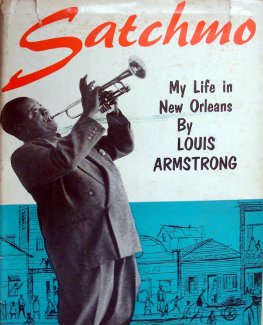
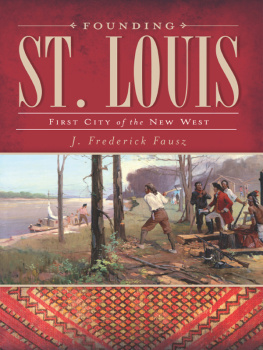
![Louis de Montfort - The Saint Louis de Montfort Collection [7 Books]](/uploads/posts/book/265822/thumbs/louis-de-montfort-the-saint-louis-de-montfort.jpg)
